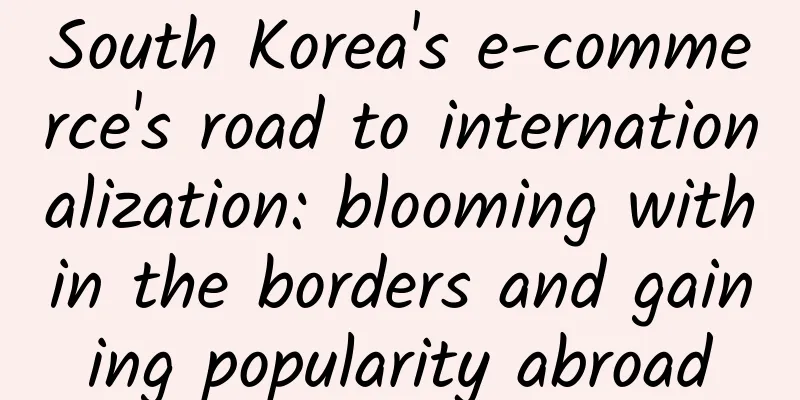South Korea's e-commerce's road to internationalization: blooming within the borders and gaining popularity abroad

|
Undoubtedly, e-commerce is the most important application model in the Internet age. This field gave birth to Internet giants such as Alibaba, Amazon, and eBay. South Korea is no exception. E-commerce has also developed rapidly, but for various reasons, it can only admire itself and cannot develop into a global giant like Samsung. Small and beautiful is almost their destiny. However, with the popularity of Korean culture in East Asia, the trend created by overseas shoppers may allow them to take off. The road to e-commerce in Korea In 1996, Interpark, a B2C model, was launched, marking the official start of online shopping in Korea. After the Asian financial crisis in 1998, Korea's special economic structure led to an economic crisis, business closures, and a high unemployment rate. The Korean government began to encourage companies and individuals to start online businesses and develop e-commerce. Many housewives began to set up personal online stores. The government implemented loose management of online stores in terms of licenses and taxes, and the rise of e-commerce in Korea ushered in a boom. 2000 was an important node in the development of online shopping in Korea. First, Gmarket was separated from Interpark, and then Gmarker, auction and 11benga divided the market into three parts. Currently, there are four major categories of e-commerce in Korea: open market platforms, such as Gmarket, 11th street, Auction; social e-commerce, such as WMF, TMON, Coupon, G9, CJ shopping; comprehensive shopping malls, such as Lotte.com, GSshop.com, new world shopping mall, Emart mall, and CJ mall; shopping search portals, such as Naver Knowledge Shopping. Gmarket and auction are controlled by eBay, while 11th street is controlled by SK telecom, a local Korean company. Currently, the top three companies in the open market platform have started social e-commerce businesses and compete with social e-commerce companies. Most comprehensive shopping malls are operated by large Korean comprehensive companies. The e-commerce model in South Korea is different from that in other countries. Neither B2C nor C2C is really B2C or C2C. B2C is called Shopping Mall. It does not store goods but signs contracts with suppliers. After consumers place an order, they notify the supplier to deliver the goods to the platform. C2C is called Open Market. Most of the sellers are enterprises. The pricing, inventory, and delivery are all controlled by the sellers themselves. In addition, all open market platforms in South Korea charge merchants fees, usually about 12% commission from merchants. For special products, such as discounted products, a commission of 7% to 10% is charged. Here it is necessary to talk about the situation of multinational giants in South Korea. Like in China, eBay and Groupon's self-operated websites failed in the Korean market. They chose to acquire local Korean e-commerce companies to understand the Korean market. They acquired Gmarket, auction, and Ticket Monster respectively, thus occupying a large market share in open market platforms and social e-commerce platforms. And they are willing to use the Korean e-commerce market as a test bed for their new ideas and business concepts, because South Korea has the highest Internet speed in the world and the highest penetration rate. Nearly 80% of the Korean people are online, and about 3/4 of Koreans have smartphones. The main target of smartphone penetration is young people between the ages of 18 and 24, accounting for 98%. South Korea's e-commerce has maintained a sustained and rapid development momentum in recent years. It is estimated that the size of South Korea's e-commerce business market was about US$47 billion in 2014. The growth rate is very fast. Compared with the first half of 2013, the growth rate in the first half of 2014 was 15.48%, reaching US$21 billion. In the past three years, the size of South Korea's e-commerce market has continued to grow at a rate of 10% or even higher every year. However, the development of e-commerce in South Korea should have been even faster, but some outdated policies have limited this possibility. The most criticized of these is the mandatory use of electronic certificates, which requires all buyers to download ActiveX controls or public certificates if they want to shop online in South Korea. This is stipulated in the "Detailed Rules for the Implementation of Electronic Financial Supervision Regulations" formulated by South Korea in 1999. Electronic payments exceeding 300,000 won (about 1,700 yuan) must use electronic certificates. Financial institutions that violate the regulations will be punished by suspension of business for up to 6 months. Because the payment procedures of Korean online shopping malls are too complicated, foreigners in South Korea and even many Koreans tend to use foreign websites such as Amazon and eBay for shopping. In 2013 alone, the consumption of Korean locals on foreign shopping websites reached 1 trillion won, while the consumption of foreigners in South Korea on Korean shopping websites was only 200 billion won. There are many problems with this policy. For example, to run the electronic certificate, you must download several firewall security controls and Active-X plug-ins. Only Microsoft's Explorer browser supports the operation of such plug-ins, and users of other browsers such as Chrome, Firefox and Safari cannot download them. If this policy is not adjusted in time, I think it is very likely that Korean e-commerce will miss out on the dividends brought by the Hallyu Wave. Korean e-commerce's internationalization path Korean e-commerce companies cannot be compared with companies in Europe and the United States in terms of going global. In fact, their development lags behind. Take China as an example. Most Korean companies have failed in entering the Chinese market, mainly because they lack understanding of the Chinese market. Some Chinese culture and systems are very different from those of Korea. More importantly, many companies do not understand what Chinese consumers want and lack localization. First, most of the key decisions are made by Korean corporate leaders. In addition, unreasonable pricing is also an important reason. The high price makes the products uncompetitive. At present, the most promising way for Korean e-commerce to go global is to import products from abroad. With the popularity of Korean dramas, Korean fashion and fashionable lifestyle products have attracted the attention of overseas shoppers from China, Japan and other countries. More and more consumers are not satisfied with traditional methods such as "same style" and "overseas purchasing" and are beginning to explore buying "authentic products" directly from Korean online shopping malls. Statistics show that in the first half of 2013 alone, the amount of spending by Chinese overseas shoppers in Korea increased by 160%. Take Gmarket as an example. According to its person in charge, the most popular items are clothing, cosmetics, Korean wave peripheral products and maternal and child products. Among them, clothing is the most popular, accounting for more than 60% of overseas shopping sales. For example, if a Chinese customer orders a dress, the price is more than 30,000 won, which is less than 200 yuan. Overseas shopping customers only need to pay 70 yuan for international shipping, while the price of the same style of dress purchased in China is more than 100 yuan more. From January to August 2013, more than 20,000 overseas shoppers became members of this website. At present, the number of orders from mainland China, Hong Kong and Macao has reached 130 to 40% of the website's overseas sales. However, the electronic certificate system mentioned above is a very big obstacle. Consumers need to undergo real-name authentication when registering in online shopping malls. The authentication channels include SMS authentication, ID card number authentication, IPIN (Internet Personal Identification Number) authentication and foreigner landing card (issued by the Korean Ministry of Justice) authentication. In order to obtain an electronic certificate, users need to go to a local bank to apply for a domestic savings card and complete security authentication by entering their ID card number, mobile phone number and local bank savings card account through the online authentication system. Foreigners do not have the above information and can only obtain electronic certificates by completing identity authentication in person at various administrative agencies. Fortunately, the relevant departments in South Korea are currently studying to change this policy, so that foreign buyers can log in to Korean websites to purchase goods without downloading controls (active X) or electronic certificates, and only need to enter the international credit card number. On the eve of National Day last year, Gmarket opened a Chinese window specifically for Chinese overseas shoppers, and simplified the registration process, eliminating the need for real-name authentication during registration. Chinese consumers only need to fill in their basic information to easily complete the registration within two minutes. After selecting the goods, overseas shoppers can directly use UnionPay cards to settle in RMB, and the ordered goods will be delivered directly to consumers via EMS within ten working days. In order to attract foreign consumers, various relevant agencies in South Korea are taking action. For example, in terms of after-sales protection, the Korea Consumer Protection Agency has clearly stated that if Chinese consumers find that the goods they receive are different from the purchased goods or are damaged, they can request a full refund or exchange within 7 days in accordance with the Korean Consumer Protection Act. If the seller does not cooperate, Chinese consumers can directly contact the agency for help using a Chinese phone number. In addition to these efforts of Korean companies and institutions, I want to enable foreign consumers to truly buy high-quality and low-priced Korean fashion products. The best way should be for Korean products to go directly to the consumers' countries through better channels, or to boldly go out. Therefore, Bang5mai is trying to make such an attempt and preparing to establish a Korea City to assist Korean companies in better entering the Chinese market. As a winner of Toutiao's Qingyun Plan and Baijiahao's Bai+ Plan, the 2019 Baidu Digital Author of the Year, the Baijiahao's Most Popular Author in the Technology Field, the 2019 Sogou Technology and Culture Author, and the 2021 Baijiahao Quarterly Influential Creator, he has won many awards, including the 2013 Sohu Best Industry Media Person, the 2015 China New Media Entrepreneurship Competition Beijing Third Place, the 2015 Guangmang Experience Award, the 2015 China New Media Entrepreneurship Competition Finals Third Place, and the 2018 Baidu Dynamic Annual Powerful Celebrity. |
<<: Behind the WeChat outage response: pretentious texts, powerless users
>>: Tablets have no future: iPad replacing PC is a false proposition
Recommend
Talking about Tint in Android Material Design
What is Tint When I first came across the word Ti...
WeChat Reading Product Analysis Report
This article would like to take WeChat Reading as...
Quantitative Learning Cloud Lecture Hall Zhixing Guest Wang Xiaoli Quantitative Learning Band Trading System Issue 03
Course Catalog other 03rd issue of Zhiliangke 47 ...
How to do online promotion and marketing? Sharing Internet promotion skills!
With the development of the Internet, mobile netw...
Re-understanding the R8 compiler from an online question
background In the past period of time, JD Android...
If it doesn’t look like the Land Rover Aurora or the Landwind X7, will anyone still buy it?
Plagiarism and imitation are the inevitable paths...
If you do insurance marketing like this, closing deals will no longer be difficult!
When selling insurance, we always encounter vario...
Keep product operation analysis
This article is a product analysis report of Keep...
Will Apple open up its iOS operating system? It missed the opportunity 30 years ago
US financial website Marketwatch wrote on Thursda...
Wuhan tea sn
Wuhan high-end tea drinking is unique and very un...
Twist your own head off for fun. Can a headless fly survive?
Flies crawl over all kinds of dirty things and on...
Bing launches "Menu Favorites" feature on mobile search client
According to foreign media reports, if you are lo...
Use your phone to adjust the photo to look high-end——Snapseed mobile color adjustment tutorial
Use your phone to adjust the photo to look high-e...
How to reduce the harm when you have to drink? Remember these 13 points!
Alcohol is a love-hate relationship for many peop...
Why are distances at sea expressed in nautical miles instead of kilometers?
We are already very familiar with the commonly us...









